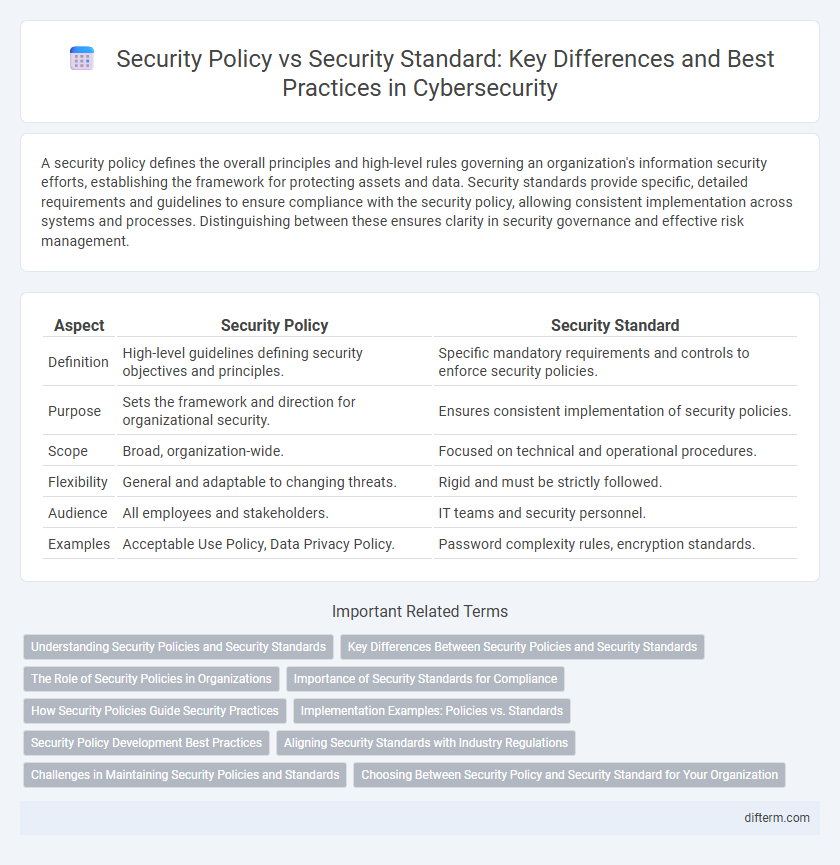A security policy defines the overall principles and high-level rules governing an organization's information security efforts, establishing the framework for protecting assets and data. Security standards provide specific, detailed requirements and guidelines to ensure compliance with the security policy, allowing consistent implementation across systems and processes. Distinguishing between these ensures clarity in security governance and effective risk management.
Table of Comparison
| Aspect | Security Policy | Security Standard |
|---|---|---|
| Definition | High-level guidelines defining security objectives and principles. | Specific mandatory requirements and controls to enforce security policies. |
| Purpose | Sets the framework and direction for organizational security. | Ensures consistent implementation of security policies. |
| Scope | Broad, organization-wide. | Focused on technical and operational procedures. |
| Flexibility | General and adaptable to changing threats. | Rigid and must be strictly followed. |
| Audience | All employees and stakeholders. | IT teams and security personnel. |
| Examples | Acceptable Use Policy, Data Privacy Policy. | Password complexity rules, encryption standards. |
Understanding Security Policies and Security Standards
Security policies define the overarching rules, intentions, and framework that guide an organization's approach to protecting its information assets. Security standards establish specific, measurable criteria and technical requirements to enforce these policies consistently across systems and processes. Understanding the distinction ensures that policies set the strategic direction, while standards provide actionable controls to achieve compliance and mitigate risks effectively.
Key Differences Between Security Policies and Security Standards
Security policies establish the overarching principles and rules that govern an organization's approach to protecting information assets, setting the framework for risk management and compliance. Security standards provide specific, detailed criteria and technical requirements to enforce those policies, ensuring consistent implementation and measurable security controls. Key differences include the policy's focus on "what" and "why" security measures are necessary, while standards define the "how" by outlining precise methods and procedures.
The Role of Security Policies in Organizations
Security policies establish the foundational framework that defines an organization's approach to managing risk and protecting assets, setting high-level directives for behavior and controls. These policies guide the development of security standards, which provide specific, measurable requirements for consistent implementation across systems and processes. Effective security policies align with organizational objectives, regulatory requirements, and industry best practices to ensure comprehensive protection and governance.
Importance of Security Standards for Compliance
Security standards provide specific, measurable requirements that ensure consistent implementation of security controls across an organization, which is crucial for regulatory compliance and risk management. Adhering to established security standards such as ISO 27001 or NIST frameworks helps organizations meet legal and contractual obligations while reducing vulnerabilities. These standards act as benchmarks for auditors and regulators, demonstrating a commitment to maintaining robust security postures and protecting sensitive data.
How Security Policies Guide Security Practices
Security policies establish the overarching framework and principles that define an organization's approach to information security, setting clear expectations for behavior and risk management. These policies guide the creation and implementation of security standards, which provide specific, measurable requirements and procedures to enforce the policy objectives. By aligning security practices with policy directives, organizations ensure consistent protection of assets, compliance with regulations, and a systematic response to emerging threats.
Implementation Examples: Policies vs. Standards
Security policies define the overarching principles and objectives for protecting organizational assets, such as requiring all employees to use strong passwords and undergo regular security training. Security standards provide specific, detailed requirements to implement these policies, like enforcing password complexity rules with a minimum of 12 characters, including uppercase letters and special symbols, and mandating multi-factor authentication for system access. Implementation examples show policies set the "what" and "why," while standards specify the "how," ensuring consistent application of security measures across the organization.
Security Policy Development Best Practices
Effective security policy development requires aligning policies with organizational goals, clearly defining roles and responsibilities, and incorporating compliance requirements. Security policies establish the overarching framework, while security standards provide detailed technical specifications to enforce those policies. Regular reviews and updates ensure policies remain relevant amid evolving threats and regulatory changes.
Aligning Security Standards with Industry Regulations
Aligning security standards with industry regulations ensures that organizational practices comply with legal and regulatory requirements, minimizing risks and potential penalties. Security policies provide the overarching framework, while security standards establish specific, enforceable criteria that reflect industry norms such as GDPR, HIPAA, or PCI-DSS. Consistent alignment facilitates audit readiness, enhances data protection, and promotes trust among stakeholders by demonstrating adherence to established compliance mandates.
Challenges in Maintaining Security Policies and Standards
Maintaining security policies and standards presents challenges such as keeping up with evolving cyber threats and ensuring consistent enforcement across all organizational layers. Organizations often struggle with aligning policy requirements to real-world practices, causing gaps between documented protocols and actual security measures. Continuous training, regular audits, and adaptive policy frameworks are essential to address these discrepancies and uphold robust security postures.
Choosing Between Security Policy and Security Standard for Your Organization
Choosing between a security policy and a security standard depends on your organization's specific needs for guidance and enforcement. Security policies define high-level principles and objectives that shape the overall security posture, while security standards provide detailed technical specifications and mandatory controls to ensure compliance. Organizations benefit from implementing both by using policies to establish security goals and standards to enforce consistent practices across all departments.
Security Policy vs Security Standard Infographic

 difterm.com
difterm.com